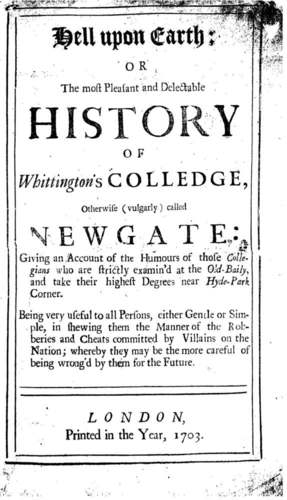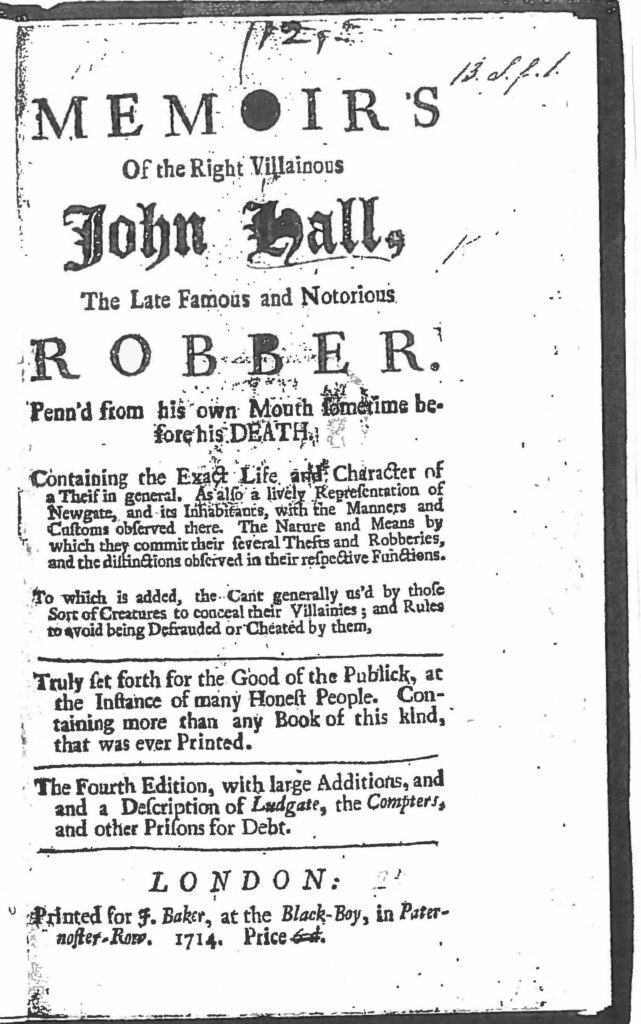- Instructor: Dr. Edward Jacobs
- Syllabus: Spring 2013
- Spring 2013 Course Project: Memoirs of the Right Villainous John Hall with Excerpts from Hell upon Earth
 This course taught students the theory and practice of producing critical, scholarly editions of literary and other texts that exist in multiple versions whose variants need to be critically reconciled as a basis for interpretive work on those texts. It was designed to prepare students for thesis/dissertation projects in scholarly editing and for careers both in academia and in publishing.
This course taught students the theory and practice of producing critical, scholarly editions of literary and other texts that exist in multiple versions whose variants need to be critically reconciled as a basis for interpretive work on those texts. It was designed to prepare students for thesis/dissertation projects in scholarly editing and for careers both in academia and in publishing.
In its theoretical aspect, the course surveyed the major theoretical approaches to scholarly editing (such as copy-text theory, versions theory, and sociological theory) and critically discussed how different theoretical approaches ramify in the fundamental editorial practices of collation (the character-by-character comparison of different versions of a work), emendation (the choice of which readings from which versions to adopt or alter for the critical edition produced), annotation (the choice of what in the editing process and in the substance of the edition needs to be explained to readers), and copy-editing (the procedures used to minimize the errors inevitably produced by any mechanical reproduction of texts, such as keyboarding, typesetting, or OCR scans). In support of this central focus on the craft of scholarly editing, the course also taught students the history and technology of textual production (from the manuscript through print into digital technologies) and the procedures of “textual criticism,” which is the process of identifying, locating, organizing, physically analyzing, and evaluating the relative “authority” of all extant versions of a work.
In its practical, productive aspect, this course produced and published to the web (as a pdf file) an open access scholarly edition of two closely related texts: Hell upon Earth (1703)—which survives in one version textual “witnessed” by a single copy—and Memoirs of the Right Villainous John Hall (1708/1714)—which survives in three versions, two witnessed by a single copy and one witnessed by two extant copies. The edition produced included a General Introduction summarizing and interpreting the role of these texts in eighteenth century British culture, a Note on the Text summarizing and justifying the editorial procedures used for the edition, the annotated texts of the works, three appendices of editorial apparatus that registered variations among the textual versions edited, and a list of Works Cited in the edition. The entire edition totaled just under 45,000 words. For M.A. students in the Literature emphasis, this course fulfilled the requirement for a course in Methodology/Theory. For PhD students, it counted as a course in the Literary and Cultural Studies emphasis.
Pedagogic Reflections
This course posed five immediate pedagogic challenges.
One was to orient students to the cultural milieu of the early eighteenth century British texts that we edited, which were chosen for the project based on three criteria: 1) they were extant in significantly different versions that merited critical editing, 2) they had not previously been edited or subject to extensive scholarly discussion, and 3) they were within the field of expertise of the professor, who in connection with other work had done some research on them before the class began. This challenge was answered by requiring the professor to draft the historical “General Introduction” to the edition, which was discussed in a workshop class approximately one month into the class and then revised by the professor and work shopped again near the end of semester. The early discussion of the professor’s draft gave all students the basic knowledge about genre, cultural and social contexts, textual history, and relevant secondary sources that students needed to critically evaluate and edit the texts, all of which knowledge students built upon and enhanced through their own research during the production process. Giving students this contextual information about the texts was crucial to enabling the class to focus on its primary subject—the theory and practice of scholarly editing—but it did require the professor to draft a roughly 10,000 word essay during the first weeks of the semester, in addition to preparing the classes in editorial theory. Although this was more work than usual for other classes, it did happen early in the semester before grading began, and was very effective in orienting students for their own critical research.
A second challenge was to coordinate the theoretical readings in textual criticism with the production of an actual edition, the latter of which by its nature needed to be done in a sequence of stages that required the entire fifteen weeks of the semester to do responsibly. This challenge was answered by starting the production process from the first class meeting, strategically beginning with the production stage that was most time-intensive and least dependent upon the theoretical readings, which was the transcription of pdf files of the four eighteenth-century textual witnesses (downloaded from Eighteenth Century Collections Online) into machine-readable MSWord files formatted to be compatible with upload to the collation software Juxta and the character-by-character proofreading of those MSWord files against the pdf scans of the eighteenth-century originals. Outside of class, based upon protocols designed by the professor and discussed during the first class meeting, each of the four teams transcribed and proofread one of the four textual witnesses, which were due just before midterm. At the same time as students did this initial production work out of class in teams, class meetings were devoted to discussion of the assigned theoretical readings that informed the subsequent, more critical/theoretical editing tasks of collation, emendation, and annotation that were executed during roughly the last half of the semester. This strategy was overall very effective, and had the corollary benefit of attuning students early on to the juncture between theory and practice, as evidenced by the fact that students regularly brought questions and problems they encountered in transcription to the classes devoted to editorial theory.
A third challenge was to organize the production process as an efficient collaboration between four different two-person teams, each responsible for different sections of the texts that we edited. This challenge was answered in two ways. First, after transcriptions were completed and before students moved into the more critical tasks of collation, emendation, and annotation that occupied roughly the second half of the semester, students individually submitted arguments for the best editorial approach to our texts, based upon theoretical readings. These arguments were then discussed and reconciled during a midterm workshop class on editorial approach, which resulted in a consensus editorial theory that was summarized by the professor in a shared document and that thereafter governed production in teams during the last half of the semester. Second, the course schedule for the second half of the semester included workshop meetings on collation, emendation, and annotation during which student teams shared and critiqued each other’s working text sections, toward the ends of correcting errors and of standardizing format and presentation of the text. These strategies were overall very effective, and again had the corollary effect of attuning students to the interaction between theory and actual practice, as evidenced by students’ questions about transcription protocols during class meetings, which resulted in a few minor but crucial adjustments to the original protocols.
A fourth challenge was to design and grade student work in a way that fairly discriminated between individual work and the team work intrinsic to the editorial process and that required more work from PhD students than from MA students. This challenge was addressed in the first case by assigning the same grade to teams for group work, but also giving individual grades for the editorial arguments and the final exam. In the second case, PhD students as a team were assigned the graded task of drafting the “Note on the Text” that described and justified our consensus editorial approach, which was revised by those students after feedback from a workshop class on their draft. This strategy was highly effective.
A fifth challenge was to exploit and supplement the affordances of the WebEx conferencing software used to teach the course so that it facilitated rather than complicated or impeded other pedagogic goals and fostered class cohesion. This challenge was answered primarily by using the share screen and share document functions of WebEx during class, especially during workshop classes, such that revisions could be collaboratively revised and saved (to Googledocs or MS Skydrive) in real time interaction. Such real time collaboration enabled the professor to offer models of corrections that teams needed to make globally, but also allowed for critical discussion of the textual and formatting minutiae crucial to any editorial project. These real time discussions of shared documents also greatly enhanced critical interaction among students and overall class cohesion.
As noted above, these pedagogic strategies were overall very effective responses to the specific pedagogic challenges posed by this course. Nonetheless, as also noted above, this course did require significantly more work from the professor than in classes less devoted to the productive implementation of theoretical principles. The nature of the course and these pedagogic strategies also required unusual flexibility and adaptation from both the professor and students as the semester progressed and pragmatic issues specific to this editorial project and to the technologies used became apparent. For example, even though the Juxta collation software was indispensable for completing the time-consuming work of comparing our four witness texts character by character within a single semester, once we had uploaded our texts to Juxta we realized that its output garbled comparisons between long passages with many variants, such that we had to take on the additional task of critically revising the Juxta output against the original pdf documents.
A sixth, more remote challenge posed by this course was the fact that its productive aspect cannot be usefully reproduced in future sections, since students in this section have already produced a web-published edition of the texts used for the course. Consequently, future sections will require the professor to identify and do preliminary research on other texts that meet the criteria identified in the above discussion of challenge one, i.e., texts that have not previously been edited but that constitute a worthy scholarly endeavor and that are within the professor’s field of specialization. Answering this challenge will add to the enhanced workload this course by its nature entails for the professor (and students), but in my judgment there is no way to avoid that continual re-invention of the course’s substance, precisely because it does teach students both the theory and practice of a genre of scholar work.

